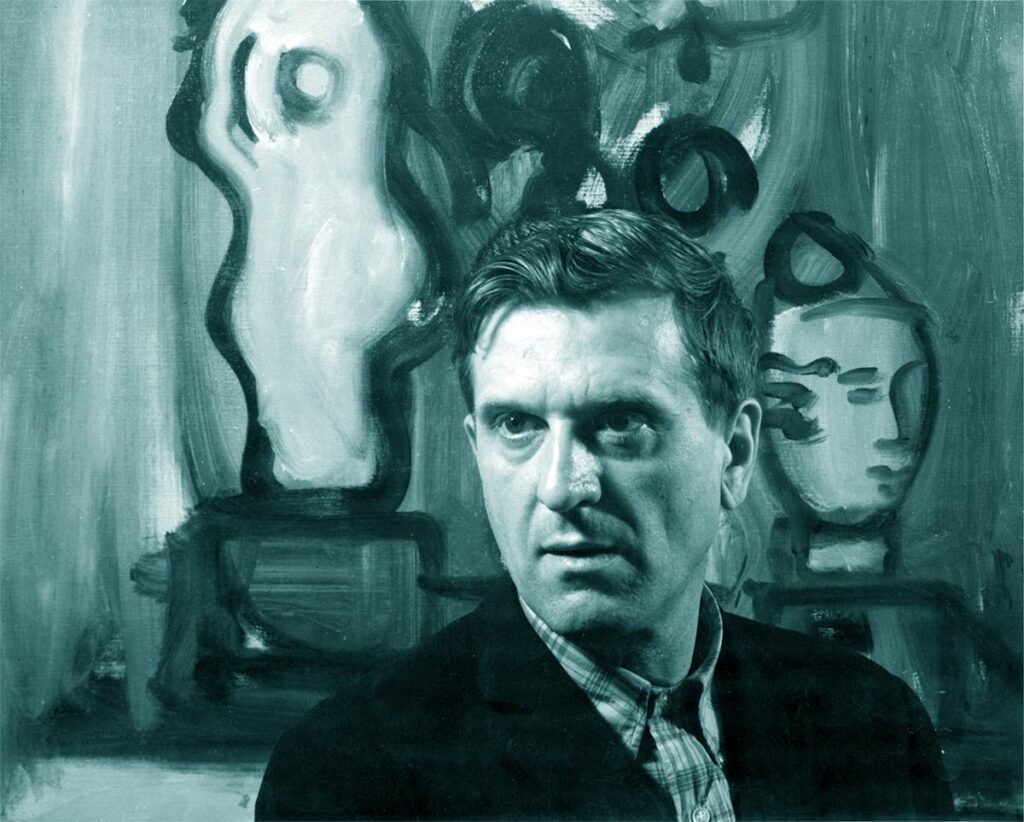Robert De Niro Sr
Robert De Niro Sr. (1922-1993) was a significant figure in American art, known for his commitment to figurative painting during a time when Abstract Expressionism dominated the art world. Despite often being overshadowed by the fame of his son, actor Robert De Niro Jr., De Niro Sr.’s contributions to modern art have earned him a place among the great painters of his generation. This biography explores De Niro Sr.’s life, artistic development, and two of his most important artworks, highlighting his enduring legacy.

Early Life and Education
Robert De Niro Sr. was born on May 3, 1922, in Syracuse, New York, to Italian-American parents. His artistic talent was evident from a young age, and his parents encouraged his interests. De Niro Sr. attended the renowned Black Mountain College in North Carolina, where he studied under Josef Albers, a former Bauhaus master. This experience deeply influenced his understanding of color and form.
He continued his education at the Hans Hofmann School of Fine Arts in New York City. Hofmann, a leading figure in Abstract Expressionism, had a profound impact on De Niro Sr.’s work, although De Niro Sr. would ultimately diverge from pure abstraction in favor of a more figurative approach. His studies in Europe, particularly in Paris, exposed him to the works of Old Masters and modern European artists, further shaping his artistic vision.
Artistic Development and Early Career
De Niro Sr.’s early work was characterized by a blend of abstract and figurative elements. In the 1940s and 1950s, he became associated with the New York School, a group of artists that included Jackson Pollock, Willem de Kooning, and Mark Rothko. However, unlike many of his contemporaries who fully embraced abstraction, De Niro Sr. maintained a commitment to figurative painting, drawing inspiration from artists like Henri Matisse and Pierre Bonnard.
His work from this period often featured vibrant colors, expressive brushwork, and a focus on the human figure. De Niro Sr.’s paintings were marked by a lyrical quality, combining elements of abstraction with a deep sensitivity to the emotional and psychological presence of his subjects. His ability to blend these influences set him apart in an era dominated by abstract trends.
Move to New York and Recognition
In 1942, De Niro Sr. moved to New York City, where he immersed himself in the vibrant art scene. His work gained recognition, and he exhibited alongside prominent artists at major galleries. In 1945, he had his first solo exhibition at the Charles Egan Gallery, which was well received by critics and established him as a promising artist.
Despite his early success, De Niro Sr. faced challenges in gaining widespread recognition. His commitment to figurative painting placed him at odds with the prevailing art movements of the time, making it difficult for him to achieve the same level of acclaim as his abstract contemporaries. Nevertheless, he continued to develop his distinctive style, producing a rich body of work that reflected his unique vision.
Important Artworks
“Still Life with Yellow Vase” (1965)
“Still Life with Yellow Vase” is one of Robert De Niro Sr.’s most celebrated works, exemplifying his mastery of color and composition. The painting features a carefully arranged still life, with a yellow vase as the central focal point. Surrounding the vase are various objects, including fruit, flowers, and fabric, rendered in vibrant hues and intricate detail.
The composition of “Still Life with Yellow Vase” reflects De Niro Sr.’s interest in the interplay of light and color. The painting’s rich palette and dynamic brushwork create a sense of depth and movement, drawing the viewer’s eye across the canvas. The yellow vase, with its bold color and central placement, anchors the composition and serves as a focal point for the viewer’s gaze.
This work demonstrates De Niro Sr.’s ability to blend elements of abstraction with a commitment to representational form. The still life arrangement, while rooted in reality, is infused with a sense of lyricism and emotion, reflecting the artist’s unique vision. “Still Life with Yellow Vase” is a testament to De Niro Sr.’s skill in creating compositions that are both visually striking and emotionally resonant.
“Woman with Violet Eyes” (1952)
“Woman with Violet Eyes” is another significant work in De Niro Sr.’s oeuvre, highlighting his sensitivity to the human figure and his ability to convey emotion through color and form. The painting depicts a woman with striking violet eyes, rendered in a palette of soft blues, pinks, and purples. The woman’s gaze is direct and penetrating, creating an intimate connection with the viewer.
The composition of “Woman with Violet Eyes” reflects De Niro Sr.’s interest in portraiture and his ability to capture the psychological presence of his subjects. The use of color, particularly the vivid violet of the woman’s eyes, adds a layer of intensity and emotion to the painting. The soft, fluid brushwork and the harmonious color palette create a sense of tranquility and introspection, inviting the viewer to contemplate the inner life of the subject.
This work exemplifies De Niro Sr.’s ability to blend abstraction with figuration, using color and form to convey the emotional and psychological depth of his subjects. “Woman with Violet Eyes” is a powerful example of his skill as a portraitist and his unique approach to modern art.
Later Career and Recognition
Despite the challenges he faced in gaining widespread recognition, Robert De Niro Sr. continued to produce significant work throughout his career. His commitment to figurative painting and his ability to blend abstraction with representation earned him the respect of his peers and the admiration of art critics.
In the 1970s and 1980s, De Niro Sr. received renewed attention, with several major exhibitions of his work held at prominent galleries and museums. His contributions to modern art were recognized with numerous awards and honors, including a Guggenheim Fellowship in 1968. These accolades helped to cement his reputation as a significant figure in American art.
Personal Life and Philosophy
Robert De Niro Sr.’s personal life was marked by his dedication to his art and his relationships with fellow artists. He was married to Virginia Admiral, an accomplished painter and poet, and their son, Robert De Niro Jr., would go on to become one of the most acclaimed actors of his generation. Despite the challenges of balancing his artistic career with family life, De Niro Sr. remained committed to his work and his artistic vision.
De Niro Sr. viewed his paintings as a means of exploring the human condition and conveying the emotional and psychological depth of his subjects. He believed in the power of color and form to evoke a wide range of responses, and his work often reflects a deep sense of curiosity and wonder about the world. His philosophy of art emphasized the importance of balance and harmony, seeking to create compositions that were both visually striking and emotionally resonant.
Legacy and Influence
Robert De Niro Sr.’s legacy as an artist lies in his ability to create a unique visual language that combines emotion, movement, and color. His innovative use of gestural abstraction and his dynamic compositions have left a lasting impact on the field of modern art, influencing generations of artists and viewers.
De Niro Sr.’s works are included in the collections of major museums and galleries around the world, including the Whitney Museum of American Art, the Hirshhorn Museum and Sculpture Garden, and the San Francisco Museum of Modern Art. His influence extends beyond his own paintings, as he also played a crucial role in advocating for the recognition and inclusion of figurative artists within the art world.
Conclusion
Robert De Niro Sr.’s artistic journey is a testament to his creativity, resilience, and profound understanding of color and form. Through his innovative use of gestural abstraction and his dynamic compositions, he created a body of work that continues to inspire and challenge viewers. “Still Life with Yellow Vase” and “Woman with Violet Eyes” are just two examples of his ability to convey complex ideas and emotions through abstract forms and vibrant colors. De Niro Sr.’s legacy as a master of modern art ensures that his work will continue to resonate with audiences for years to come.



